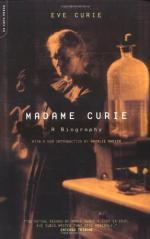|
This section contains 744 words (approx. 2 pages at 400 words per page) |

|
Madame Curie Summary & Study Guide Description
Madame Curie Summary & Study Guide includes comprehensive information and analysis to help you understand the book. This study guide contains the following sections:
This detailed literature summary also contains Topics for Discussion on Madame Curie by Ève Curie.
Madame Curie: A Biography details the struggles and triumphs of one of the most famous scientists in the world. Marie's daughter Eve, the younger of the Curies' two children, wrote the biography clearly in reverence to her physicist mother. An artist and musician, Eve recreates moments from her mother's life in lyrically written scenes transposed with Marie's letters and journal entries, painting a vivid picture of the world-renowned physicist's personal and professional life.
Marie Curie is born Marya Sklodovski in 1867 to Polish parents in Warsaw. She grows up under a Russian regime that forbids her to speak her native Polish language. Her mother dies of tuberculosis when Marya is 11 years old. The loss of her mother and eldest sister devastates her, but her father remains to cultivate an environment of intellectualism that continues to influence her throughout her life. Marya, called Manya by her family, receives a gold medal, the highest grade she could achieve in high school, but her scientific career does not begin until she is 24 years old. Manya works as a governess until her sister completes medical school, at which point she moves to Paris to attend the University of France at Sorbonne. There, she registers as Marie Sklodovski.
Marie works tirelessly to achieve a master's degree in physics and a second master's degree in mathematics. While working on her doctor's thesis, she meets Pierre Curie, and the two physicists take to each other. Marie resists love at first because she had been stung too deeply by a failed romance in Poland. Eventually, Pierre wins her over with his brilliance and a surprising wellspring of poetic sensibility. They marry in 1895 and their first daughter Irene is born in 1897. Early on, the keys to domestic life elude them. They keep little furniture for fear of housework taking too much time away from their work. Marie and Pierre are happiest in the laboratory or out traveling through the countryside on their bicycles, and they hardly leave each other's side.
Pierre stands beside Marie as she changes the world through scientific revelation. While working on her doctorate in a small glassed-in studio of the University of France, Marie discovers two new elements -- polonium and radium. Marie and Pierre work past the point of exhaustion to prove their discovery and to care for their young daughter. Radium provides the means for X-Rays, photography, and cancer treatment, so soon an industry springs up around the substance.
The world repays the Curies for their work in acclaim and honors that the couple does not want. Shortly before celebrating the birth of their second daughter, Marie and Pierre receive the Nobel Prize in Physics for their work with radium. However, the couple shuns the fame the prizes bring them, and they refuse to patent radium, preferring a laboratory in which they could continue their work. That coveted laboratory eventually becomes the Institute of Radium in Paris, but Pierre does not live to see it. He dies in 1906 in an accident while crossing the street.
Pierre's death leaves Marie devastated. Described as timid and reserved by her daughter, Marie Curie is not one to weep openly in public. Marie plays the part of the stoic intellectual, raising her daughters while, at the same time, continuing her work on radium. According to her daughter, at no point does Marie feel the need to sacrifice her career in order to have a family. Far from feeling neglected, Marie's daughters revere their mother as much as the public reveres this towering example of female intellectual brilliance.
During World War I, Marie donates and organizes mobile X-Ray units to assist wounded soldiers. She creates an Institute of Radium in Warsaw to aid the Polish scientists who had inspired her. Crowds of adoring fans meet her when she tours America, and her daughters revere her until the end of her days. At the time of her death, Marie was a teacher, mother and scientist. Today the world remembers her as the first woman to receive a Nobel Prize.
The original edition of Madame Curie: A Biography was published in 1937, three years after Marie Curie's death. The 2001 edition includes an introduction by Natalie Angier, who hails Curie as a pioneer of women's liberation and a powerful force in science. Marie Curie sacrifices herself on many levels for the sake of science, as illustrated by her death, but she also sacrifices her time, her comfort, and her privacy in the pursuit of science.
Read more from the Study Guide
|
This section contains 744 words (approx. 2 pages at 400 words per page) |

|



